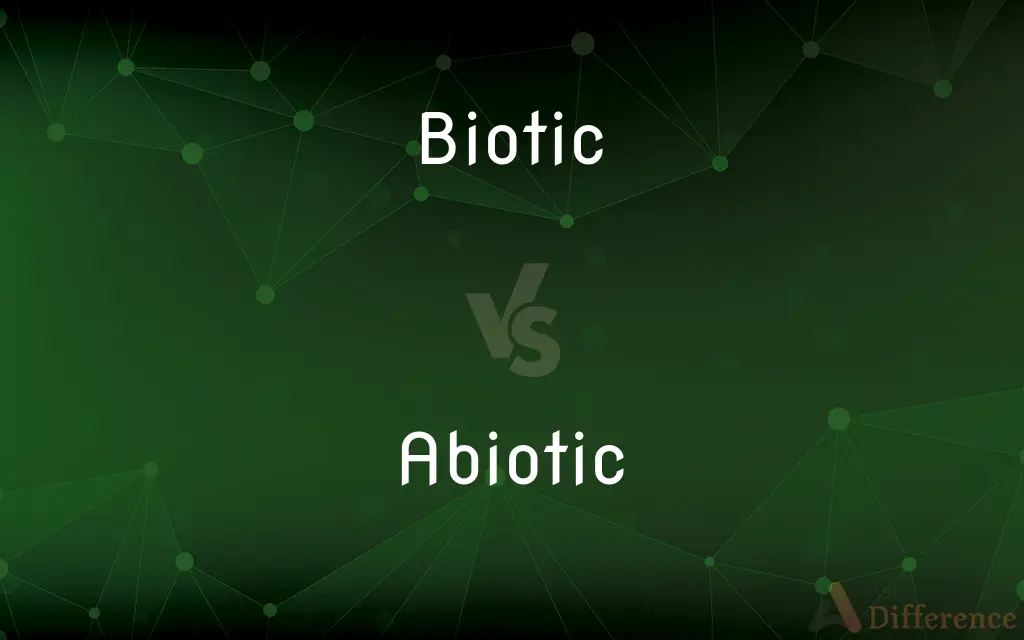Biotic vs. Abiotic — What's the Difference?
By Tayyaba Rehman & Fiza Rafique — Updated on April 18, 2024
Biotic factors are living or once-living organisms in an ecosystem, such as plants and animals, while abiotic factors are non-living physical and chemical elements, like water and minerals.

Difference Between Biotic and Abiotic
Table of Contents
ADVERTISEMENT
Key Differences
Biotic factors include all living components of an ecosystem, such as plants, animals, and microbes, which interact with each other and their environment. In contrast, abiotic factors encompass the non-living environmental components like climate, soil, water, and sunlight, which significantly influence living organisms' conditions and survival.
The interactions between biotic factors involve processes such as predation, symbiosis, and competition, which are essential for the regulation and stability of ecosystems. Conversely, abiotic factors impact these interactions by determining the physical environment that supports these biological activities.
Biotic components are capable of reproduction and growth, adapting over time through processes like evolution and natural selection. On the other hand, abiotic elements do not possess life but can undergo changes that affect ecosystem dynamics, such as geological transformations and climate shifts.
The health and distribution of biotic factors are directly influenced by abiotic conditions. For instance, water availability can limit plant growth, which in turn affects the entire food chain. Conversely, the presence of certain biotic factors, such as plant cover, can also influence abiotic conditions by affecting soil stability and microclimates.
Conservation efforts often focus on maintaining the balance between biotic and abiotic factors. Protecting an endangered species (a biotic factor) may involve managing the quality of water and soil (abiotic factors) to preserve its habitat.
ADVERTISEMENT
Comparison Chart
Definition
Living components of an ecosystem
Non-living environmental components
Examples
Animals, plants, bacteria
Water, temperature, minerals, light
Role in Ecosystems
Directly involved in biological processes
Shape the physical environment
Interaction Type
Biological interactions (e.g., competition, symbiosis)
Physical and chemical influences
Influence on Ecosystem
Influence through biological activities
Influence through physical conditions
Compare with Definitions
Biotic
Exhibits diversity and complexity in relationships.
The symbiotic relationship between bees and flowers promotes pollination.
Abiotic
Non-living chemical and physical parts of the environment that affect ecosystems.
Abiotic factors like sunlight influence photosynthesis rates.
Biotic
Essential for the flow of energy and cycling of nutrients.
Decomposers like fungi break down dead organic matter.
Abiotic
Integral to defining ecosystems and their limitations.
Water salinity levels can influence the types of organisms in aquatic environments.
Biotic
Includes all organisms that interact within an ecosystem.
Predators, such as wolves, play a vital biotic role in controlling deer populations.
Abiotic
Includes elements that are foundational to the setting of ecological processes.
Soil quality can determine the types of plants that can grow in an area.
Biotic
Pertaining to life, involving the living components of the environment.
Biotic factors like pollinators are crucial for plant reproduction.
Abiotic
Can vary over time and impact the adaptability of biotic factors.
Climate change (abiotic) is altering habitats globally.
Biotic
Can influence and be influenced by abiotic factors.
Coral reefs (biotic) are affected by ocean acidity (abiotic).
Abiotic
Affects the distribution and health of organisms.
Temperature and rainfall patterns dictate animal migration routes.
Biotic
Of or having to do with life or living organisms.
Abiotic
Nonliving
The abiotic factors of the environment include light, temperature, and atmospheric gases.
Biotic
Produced or caused by living organisms.
Abiotic
Nonliving, inanimate, characterised by the absence of life; of inorganic matter.
Biotic
(biology) Of, pertaining to, or produced by life or living organisms
Abiotic
Tending to inhibit or destroy life; antibiotic; incompatible with life.
Biotic
A nutritional substance that improves the health of gastrointestinal microorganisms, especially one that occurs naturally.
Abiotic
Any such material
Biotic
A simple organic organism that is more complex than an organic molecule but simpler than a plant or animal.
Biotic
Relating to life; as, the biotic principle.
Biotic
Produced by or caused by living things.
Biotic
Of or relating to living organisms
Common Curiosities
How do biotic and abiotic factors interact?
Biotic and abiotic factors interact constantly; for example, sunlight (abiotic) affects plant growth, which in turn influences herbivore populations (biotic).
Why are both biotic and abiotic factors important in an ecosystem?
Both are essential for sustaining ecosystems; biotic factors maintain biological processes, while abiotic factors provide the necessary physical environment.
What role do abiotic factors play in biodiversity?
Abiotic factors like climate and terrain play critical roles in shaping biodiversity by determining which species can survive in a particular environment.
What are some methods to study abiotic factors?
Methods include meteorological monitoring for climate variables, soil sampling for composition analysis, and water quality testing.
How do biotic factors adapt to changes in abiotic factors?
Biotic factors adapt through evolutionary changes, such as developing drought resistance in plants due to prolonged dry conditions.
Can biotic factors alter abiotic factors?
Yes, for example, plant growth can change soil stability and composition, which are abiotic factors.
Can abiotic factors change over time?
Yes, abiotic factors such as climate and soil composition can change due to natural processes and human activities.
How do humans impact biotic and abiotic factors?
Human activities such as pollution and deforestation can alter abiotic factors, thereby affecting biotic life in those ecosystems.
What is the difference between biotic and abiotic factors?
Biotic factors are living elements within an ecosystem, while abiotic factors are the non-living physical and chemical aspects of an environment.
What is an example of a biotic factor affecting another biotic factor?
A classic example is predation, such as wolves preying on deer, which affects both species' populations and behaviors.
Are there ecosystems where abiotic factors are more influential than biotic factors?
In extreme environments like deserts and polar regions, abiotic factors like temperature and available moisture are more influential on biotic life.
How do changes in abiotic factors affect food chains?
Changes in abiotic factors can alter food availability and habitat conditions, impacting the entire food chain from primary producers to apex predators.
How can the study of abiotic factors help in conservation?
Understanding abiotic factors helps in habitat restoration and management, crucial for conserving endangered species.
What are some challenges in managing ecosystems due to biotic and abiotic factors?
Challenges include predicting interactions between complex biotic relationships and rapidly changing abiotic conditions, especially under climate change scenarios.
What abiotic factors are most critical for plant life?
Critical abiotic factors for plants include sunlight, water, soil nutrients, and temperature.
Share Your Discovery

Previous Comparison
Islam vs. Muslim
Next Comparison
Touch vs. TourchAuthor Spotlight
Written by
Tayyaba RehmanTayyaba Rehman is a distinguished writer, currently serving as a primary contributor to askdifference.com. As a researcher in semantics and etymology, Tayyaba's passion for the complexity of languages and their distinctions has found a perfect home on the platform. Tayyaba delves into the intricacies of language, distinguishing between commonly confused words and phrases, thereby providing clarity for readers worldwide.
Co-written by
Fiza RafiqueFiza Rafique is a skilled content writer at AskDifference.com, where she meticulously refines and enhances written pieces. Drawing from her vast editorial expertise, Fiza ensures clarity, accuracy, and precision in every article. Passionate about language, she continually seeks to elevate the quality of content for readers worldwide.














































